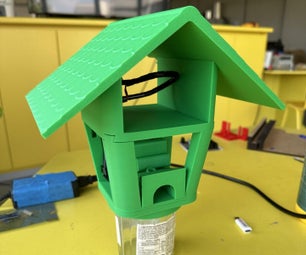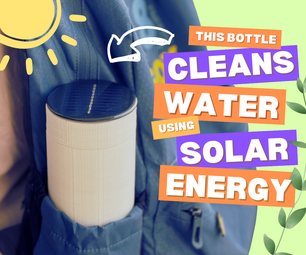Introduction: Itty Bitty Joule Thief
A Joule Thief is a simple circuit that takes advantage of the inductive kickback produced by an inductive element (a wound toroid in this case) to step up the voltage. This extra voltage at the output of the circuit can be used to power devices which would not work with the input voltage alone. In this case that voltage is used to light an LED, which would not be able to light up with a single AA battery as the voltage required to do so is 3.3 volts, while the battery can only provide 1.5 volts at its best.
The joule thief can operate with very low voltages, this means it can work with batteries which would normally be considered "dead", taking energy from them in a seemingly impossible way, hence it's name.
In this instructable I'll show you how to build a tiny joule thief mounted on a piece of copper clad board.
Step 1: Materials:
- 2N2222 transistor
- 1k to 10k resistor (to select the brightness)
- Copper clad board
- 1x AA battery holder
- 1x LED (I used white, but any color will work)
- Solder
- 1x small toroid* (less than 1cm of outer diameter)
- Around 20-30 centimeters (8-12 inches) of thin copper wire
- Epoxy
*Small toroids like the one I used can be easily obtained out of small CFLs, not all CFLs have them, but there's a high chance you'll find one inside. Not all toroids will work, it's wise to test the circuit in a breadboard before assembling it.
Step 2: Etch the Board
I first start by cutting a piece of copper clad board with the size of an AA battery, I will stick it to the back of the AA holder, so it must have the correct dimensions. In this case the dimensions are 1.2 x 5 centimeters.
To etch the board I stick some tape on both sides after scrubbing and cleaning it with alcohol, this will remove any oils left by my fingers which could ruin the process, it is also important to seal the edges too so the etchant doesn't eats them away.
Next I cut the shape of the circuit with an x-acto knife as seen in the pictures, the exposed areas will be eaten away. This disposition is fine as it is and I encourage you to use it, but you can always improve it's design.
To etch the board I use a mixture of Hydrochloric acid (20-30%) (also known as muriatic acid, pool cleaner or HCl) with hydrogen peroxide (3%) (also known as a common wound disinfectant) in a 1:2 ratio, 1 part of HCl per 2 parts of H202 . This solution can't be reused as it's unstable and will loose its power within some hours.
The etching process usually takes from 5 to 10 minutes.
After the board is etched I remove the sticky tape and I continue with the next step.
Step 3: Winding the Toroid
Winding the toroid can be a little frustrating, specially if your toroid and wires are very small. First you must take a piece of wire around 25cm long (depending on the size of your toroid) and bend it in half so you have two wires parallel to each other, then you start winding those two wires at the same time (from 10 to 20 times) until you end up with something like in the image. As you can see, the wires should should not cross each other.
Next, you have to connect the two inner wires as seen in the image, these will be connected to positive. The remaining two wires can be connected to the resistor that will be connected to the base or to the collector, it doesn't matter which way around.
Step 4: Completing the Circuit
The circuit is quite simple, but it can get confusing when soldering it onto the board.
I first tin all the pads on the board, this will avoid the copper from deteriorating and gives it a nice appearance, then I solder the toroid positive wire to the positive pad at the bottom, the two other wires will be connected
indistinctly to the pads at the right and the left.
I connect one end of a 2.2k resistor to the pad at the left and the other end to the "base" pad just above it. You can choose the brightness with this resistor. After finishing the circuit, if the current going in is higher than 30mA you can increase the value of the resistor in order to reduce it.
To connect the transistor I connect the collector to the upper right pad, the emitter to the upper left pad (the negative pad) and the base to the "base" pad just below it.
I finally solder a SMD LED taken from a LED bulb between the collector (positive) and the "emitter" (negative) pads. You can solder any kind of LED.
Once the circuit is complete I use acetone and a q-tip to remove most of the flux that was on the board, then I use epoxy to hold it to an AA battery holder, I use the remaining epoxy to seal the toroid and its wires, which can be easily damaged.
To finish it all I solder the positive wire coming from the holder to the positive pad at the bottom and the negative wire to the negative pad, connected to the emitter and to the negative pad of the LED.
IMPORTANT:I used a P2N2222A transistor, not a 2N2222A or a PN2222A, this means the collector and emitter are swapped, check your transistor's pinout before soldering it.
Step 5: The End
This circuit uses around 20-30mA, this means it can last more than 50 hours on a fresh AA battery as calculated by an online battery life calculator. It's also quite bright, so it could be of some use in an emergency situation.
EDIT: I tried to see how much it would last on a fresh AA battery (a generic one), I connected it on Friday night at 24:00 hours and it's still running, without a very significant significant drop in brightness, two days later, Monday morning, almost 50 hours of continuous use. After the first day the voltage dropped from 1.48 volts to 1.20 volts, now it's at 1.05 volts.
EDIT 2: One day later it's still running, the brightness has dropped significantly, but it can still be used to see in the dark without problems (see 3rd picture) , the voltage is now at 0.78 volts. It's been running for three days straight.
EDIT3: The battery seems to have really died at some point during the Tuesday morning after 6 am, in total it's been running for almost 80 hours.
Thanks you for reading this instructable.











